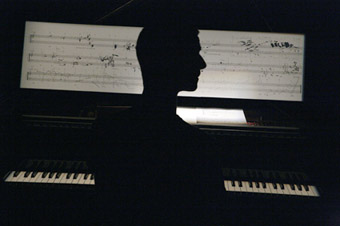 |
Mark Knoop, Val Camonica photo Yatzek |
Aphids’ new work concerns Val Camonica, a valley in the northern Italian Alps, where thousands of rock carvings dating from 3,000 to 8,000 years ago record the life of the Camunni people—their hunting, tools, houses, rituals and lifestyles. The reinterpretation of the cultural history and imagery of Val Camonica through a suite of music, text and video is an ambitious project artistically, one which itself forms part of the cultural lineage that the site has generated.
The first of the seven Val Camonica Pieces, Incisioni Rupestri, is for solo piano. Opening with brief, quizzical motifs alternating with long pauses, the colour and intensity build, punctuated with percussive taps on the piano lid and the strumming of piano strings. Mark Knoop’s rendition is scintillating, and while the work might be understood as a programmatic reference to the initial archaeological recognition of the Camonica inscriptions, the writing and the pianism make for delightful music.
The second piece, Inventario, for strings, winds, brass and percussion, extends some of these ideas. The opening bass drum roll heralds a stop-start progression of motifs, each based around various instrumental combinations, suggesting categories of visual form. In the absence of melodic or rhythmic structure, the coherence of the work emerges from Knoop’s precise conducting, through which the inventory unfolds and which also suggests the march of pictorial and cultural categorisation. The Libra Ensemble’s fine playing articulates these musical ideas and Louise Curham’s grainy black and white footage of forest scenes hints at an alternative, cinematic archaeology.
Stile I, II and III, for guitar and cello, is quiet and introspective, dwelling conversationally on particular musical figures. By contrast, the next piece, Roccia, for violin, piano, clarinet and percussion, is energetic and dramatic, personifying the rocky landscape itself. Throughout the Val Camonica Pieces, strings are sometimes bowed so as to make scraping sounds, perhaps suggesting the chiselling of rock. When used with brass, basses and percussion, the scraping creates a gritty earthiness that evokes the harshness of early alpine civilization. In the fifth piece, Sarcophagus, for string octet, it is as if human figures are engaging in ritual exchanges.
Throughout the suite, Young makes frequent use of portamento—slurred or sliding notes and glissandi that might span one or two semitones and sometimes several tones. The effect is to suggest motion, as if the human and animal figures in the rock carvings are coming to life. In the strings, the frequent use of sliding notes together with rapid shifts between bowing and pizzicato, abrupt changes of metre, sudden accents and shifting dynamics create the consonants, vowels, syllables and even the flow of speech, and the listener gains the impression that Young has painstakingly decrypted and translated every detail of the site into note-by-note musical ideas, as if creating new words and phrases from a novel alphabet. This is especially so in the final piece, Animali, an extended violin solo, where Young adds double-stopping and sometimes requires the performer to hold one note while sliding another, creating an eerie multiple voicing.
However, while commencing with conventional notation, a score will typically conclude with graphic elements including transcriptions of the rock carvings. The final passages of the Roccia score comprise silhouettes of animals, requiring the musicians to respond directly to the Camonica imagery. The concluding piece, Animali, is accompanied by a projected image of the score scrolling across the screen, so viewers can see how notation segues into graphic material inscribed on the stave and can thus appreciate how different kinds of abstract markings might be interpreted. Animali draws together the musical ideas of the earlier pieces into an original and eloquent musicality. Violinist Yasutaka Hemmi’s realisation of this piece is breathtaking, and Animali is a significant musical achievement for both composer and performer.
Accompanied by video imagery from the site, the penultimate piece, Val Camonica: an Excavation, is a text written and read by Cynthia Troup that discusses the archaeological mapping of the site and the interpretation of its imagery, and reflects on the “continuity and consistency of human existence” it reveals. In considering how a public, visual record such as Val Camonica identifies and informs cultural evolution, Young and Troup reconsider the theoretical basis and cultural impact of archaeology itself.
Val Camonica Pieces: Aphids in association with the Libra Ensemble, composition David Young, film Louise Curham, text Cynthia Troup; Full Tilt, Arts Centre, Melbourne, May 10-11
RealTime issue #79 June-July 2007 pg. 38
© Chris Reid; for permission to reproduce apply to [email protected]








 back
back